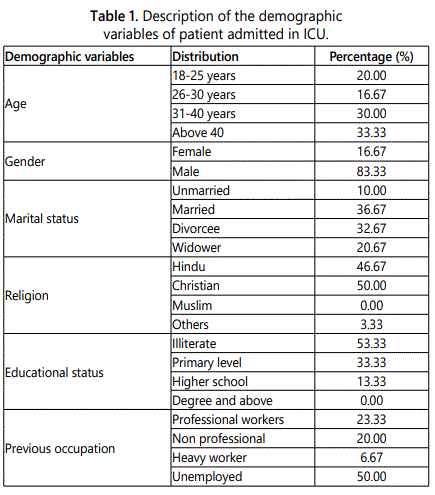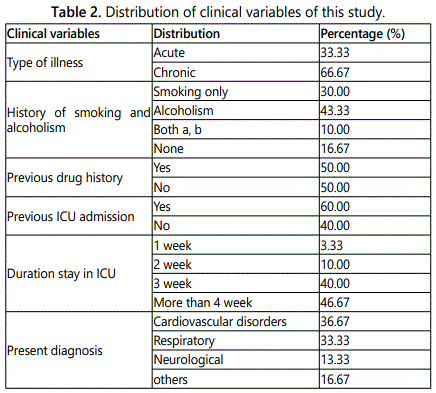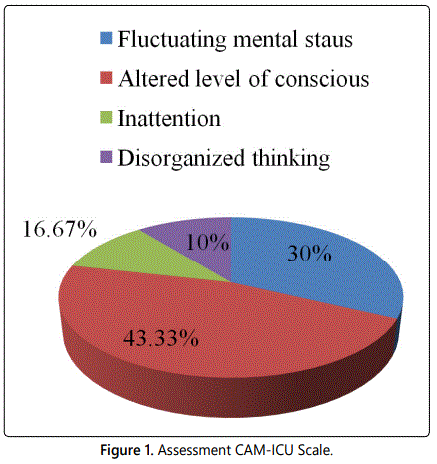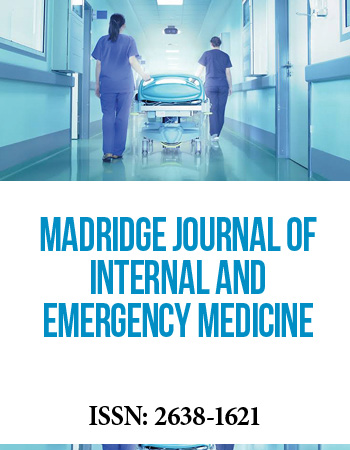Research Article
Prevalence of ICU Delirium among Patients admitted to Intensive Care Unit
Department of MSN, College of Nursing, Mother Theresa Post Graduate & Research Institute of Health Sciences, Puducherry, India
*Corresponding author: Nivethitha Kandasamy, Department of MSN, College of Nursing, Mother Theresa Post Graduate & Research Institute of Health Sciences, Puducherry, India, E-mail: nivi.mahi@yahoo.in
Received: April 12, 2019 Accepted: April 26, 2019 Published: May 7, 2019
Citation: Lalithapriya P, Nivethitha K, Chitra F. Prevalence of ICU Delirium among Patients admitted to Intensive Care Unit. Madridge J Intern Emerg Med. 2019; 3(2): 121-124. doi: 10.18689/mjiem-1000128
Copyright: © 2019 The Author(s). This work is licensed under a Creative Commons Attribution 4.0 International License, which permits unrestricted use, distribution, and reproduction in any medium, provided the original work is properly cited.
Abstract
Background: Disease is an abnormal process that affects all aspects of the human life. The hospital environment and particularly the intensive care unit (ICU) causes stress in the patient and his/her family. So the critically ill patient necessary to assess the ICU Delirium.
Aim: This study was designed to assess the prevalence of ICU delirium patients admitted in Intensive Care Unit.
Subjects and methods: A descriptive study was conducted among patients admitted in Intensive Care Unit at Puducherry. Sample size was 30, selected through purposive sampling. The approach used was Quantitative approach and descriptive design was used in this study. The investigator assessed the ICU delirium among patients using the Richmond Agitation and Sedation Scale and CAM-ICU Scale.
Results: The data revealed that ICU delirium is present in the current scenario and majority of the cases are differentiating it from hypoactive and hyperactive ICU delirium rather than considering the patient to be in a drowsy or sedative state. The evidence suggests that out of 30% of the subjects, who developed ICU delirium 6.67% of them had hypoactive ICU delirium and 23.33% had hyperactive ICU delirium.
Conclusion: ICU delirium is now becoming a major threat to the health care professionals because many of the studies reveals that the percentage of patients suffering from ICU delirium is being increasing day by day amidst this technological developments. It has really become a challenge for the health professionals to detect ICU delirium at the earliest so that they can prevent the cognitive impairment.
Keywords: ICU delirium; Intensive Care Unit; RASS Scale; CAM-ICU Scale.
Introduction
Critical care environment is complex, life threatening and alien to the patient. The depersonalization of the patient and staff with the ICU dress, use of all kinds of machines and jargons makes the environment vulnerable for the patients [1].
In addition to the physical stress of illness, pain, sedation, interventions, and mechanically ventilation, there are psychological and psychosocial stressors perceived by these patients. One of the additional factors is the ICU environment, which is thought to contribute the syndrome known as ICU delirium [2].
According to American Psychiatric Associationʼs (APA) Diagnostic and Statistical Manual of Mental Disorders (DSM)-IV, Delirium is defined “as a disturbance of consciousness and cognition that develops over a short period of time (hours to days) and fluctuates over time.” Many different terms have been used to describe this syndrome of cognitive impairment in critically ill patients, including ICU psychosis, ICU syndrome, acute confusional state, septic encephalopathy, and acute brain failure [3].
The causes of delirium have been divided into patient factors, pharmacological factors, and environmental factors. Patient factors could be individual (like severe comorbidity, previous episode of delirium, and personality before illness), perioperative (like course of postoperative period, and type and duration of operation) and specific conditions (like depression and alcoholism). Pharmacological factors include treatment with many drugs, dependence on drugs or alcohol, use of psychoactive drugs or alcohol and specific drugs that may cause problems like benzodiazepines, anti cholinergic agents and narcotics; while environmental factors include extremes in sensory experience for e.g., hypothermia, deficits in vision or hearing, immobility or decreased activity, social isolation and novel environment [4].
A study was conducted on Implementation of a delirium assessment tool in the ICU can influence haloperidol use, at the Radboud University Nijmegen Medical Centre, Netherlands which believe that “although there has been increasing interest in delirium in the past five years, standard screening of patients in daily practice is still not common, resulting in an underestimation of the problem. The studies showed that, without the use of a screening instrument, more than 60% of patients with delirium are missed by ICU nurses and more than 70% by physicians which can be assumed that delirious patients are not sufficiently treated if they are not recognized. The incidence rate in critically ill patients varies between 11% and 87%, depending on the study design, methods for assessment, and differences in population. Early recognition of delirium is important for adequate and early treatment. Therefore a quick and easy delirium assessment tool should be used with a high interrater reliability. Intensive care delirium screening checklist (ICDSC) and the confusion assessment method-ICU (CAM-ICU) are the two validated delirium screening instrument recommended to screen the ICU patients for ICU delirium [5,6].
Objectives
1. To assess the prevalence of ICU delirium among patients admitted in ICU of selected hospital.
2. To find the association between the prevalence of ICU delirium with selected socio-demographic variables.
Methodology
Research approach is the basic procedure for conducting the study, the present study aimed at assessing ICU delirium patient admitted in Intensive Care Unit. In order to achieve the objectives, a quantitative research approach was found to be appropriate. Research design used for this study is a descriptive study (non-experimental) and research variables are ICU delirium and patient admitted in ICU. The study was conducted in Indira Gandhi Government General Hospital and Research Centre. The population comprise of this study patient admitted in Intensive Care Unit at Indira Gandhi Government General Hospital and Research Centre at Puducherry. The sample size comprised of 30 Patients admitted in Intensive Care Unit. Sampling technique is a process of selection of portion of the population to represent the entire population. Purposive sampling technique was used for this study [1]; Inclusion criteria of sample were patients who are admitted to ICU for more than 24 hours [2]. Conscious patients who are willing to participate in the study [3]. Inattentive and ventilated patients whose guardians will permit to observe the patient for delirium using CAM-ICU tool [4]. Patients who scores between -3 to +4 on Richmond Agitation and Sedation Scale (RASS).
The tool description was divided into three sections. Section A: This section contains part-I demographic variables including age, gender, marital status, religion, educational status, previous occupation. And part-II clinical variables are including type of illness, history of smoking and alcoholism, previous ICU admission, previous drug history for co-morbid condition, duration of stay in ICU, and present diagnosis. Section B: This section contains assessment of level of consciousness by using Richmond Agitation and Sedation Scale (RASS). Section C: This section contains Confusion Assessment Method for ICU (CAM-ICU Scale). The tool consists of 16 items covering four areas which include the following: [1]. Feature 1- acute onset or fluctuating course of mental status (pre hospital mental status, acute change from mental status baseline and fluctuation in mental status during past 24 hours) [2]. Feature 2- in attention (listening to series of letters, seeing and memorizing a series of pictures, recollecting the previous pictures from the new ones) [3]. Feature 3- altered level of consciousness (current RASS score) [4]. Feature 4- disorganized thinking (step 1, four Yes or No type questions and step 2 contains another set of four Yes or No questions, and responding to the command by doing an action). Data collection procedure include prior permission was obtained from the Nursing Superintend of Indira Gandhi Government General Hospital and Research Centre at Puducherry. The data collected was from the patients admitted in Intensive Care Unit, Indira Gandhi Government General Hospital and Research.
Results
The results describe that General characteristics of the subjects, the 33.33% were in the age group of 31-40 years, in gender 83.33% were male, 36.67% were married, 53.33% had illiterate, 46.67% had belong to Hindu, 50% were non professional workers (Table 1). Whereas in clinical variables, 66.67% had chronic type of illness, 43.33% had habit of alcoholism, 50% had previous drug history, 60% had previous ICU admission, 46.67% had stay in ICU more than 4 weeks, and 36.67% had cardiovascular disorders (Table 2).


Whereas in Level of ICU sedation using RASS Scale Ten (33.33%) of the participants were Alert and Calm, eleven (36.67%) were drowsy, whereas nine (30%) were Agitated, Restless and in Light sedation. Whereas ICU Syndrome assessment using CAM-ICU Scale, the disorganized thinking from this selected participants nine (30%) were CAM-ICU Positive i.e. by the presence of feature 1, feature 2 and either feature 3 or feature 4. Out of this CAM-ICU Positive cases seven (23.33%) had Hypoactive ICU Syndrome and two (6.67%) had Hyperactive ICU Syndrome.
Confusion Assessment Method for ICU patients revealed that nine (30%) of the subjects were with fluctuating mental status, thirteen (43.33%) had altered level of consciousness, five (16.67%) had inattention and three (10%) were with score as positive, therefore the individual present with ICU Syndrome (Figure 1). Thus ICU Syndrome was assessed and the data showed that 30% of the subjects admitted in the ICU developed ICU Syndrome during their ICU stay whereas 70% of the subjects were free of ICU Syndrome in the assessment for consecutive three days using the CAM-ICU Scale. The mean score for the presence of ICU Syndrome was three.

Discussion
In the present study the level of ICU sedation was assessed using the standardized Richmond Agitation and Sedation Scale. It has got certain scores based on which the sedation is being classified. In this study majority 33.33% of the subjects were Alert and Calm with a RASS Score of 0 and 36.67% were drowsy, 10% were agitated, 10% were restless, 10% were in light sedation. In the present study the prevalence of ICU Syndrome in a selected Hospital was calculated using the formula and was found to be 30%. In a similar study conducted in Chandigarh it was revealed that incidence and prevalence rate of delirium were 24.4% and 53.6% respectively which means that delirium was highly prevalent in the ICU setting and delirium is associated with longer ICU stay and higher mortality [7-9].
According to CAM-ICU scale 44.33% of the subjects had Altered Level of Consciousness, 16.67% had Inattention, whereas 30% had Fluctuating Mental Status and 10% had disorganized thinking. The scores calculated for individual subjects showed the CAM-ICU Confusion Assessment Method for ICU patients revealed that nine (30%) of the subjects were with fluctuating mental status, thirteen (43.33%) had altered level of consciousness, five (16.67%) had inattention and three (10%) were with score as positive, therefore the individual present with ICU Syndrome. Thus ICU Syndrome was assessed and the data showed that 30% of the subjects admitted in the ICU developed ICU Syndrome during their ICU stay whereas 70% of the subjects were free of ICU Syndrome in the assessment for consecutive three days using the CAM-ICU Scale. The mean score for the presence of ICU Syndrome was three.
The subjects were again classified based on their presence of ICU Syndrome depending upon its type. The results showed majority 70% of subjects were Normal, 6.67% had Hypoactive ICU Syndrome whereas 23.33% had Hyperactive ICU Syndrome. A similar study was conducted to identify the psychopathological factors in hyperactive and hypoactive ICU Syndrome which shows that among the patients who have developed ICU Syndrome, 70% patients had hyperactive delirium while 30% was having hypoactive delirium.
Therefore it is really a matter of concern for the health care professionals as early detection can reduce the mortality rate as well as the cognitive impairments. The main purpose of the study was to assess ICU Syndrome among patients admitted to ICU. The findings of the study provide useful information to health planners and adopt measures to reduce the incidence of ICU Syndrome and certain facts that have far reaching implications in the field of nursing practice, nursing research, and nursing administration. This study has helped to prove the prevalence of ICU Syndrome in the given setting. It also revealed that the preventive practices should be improved and nurses given proper guidance in the assessment of ICU delirium [10,11].
References
- Kuruvilla J. General aspects of care. In: Kuruvilla J (ed). Essentials of Critical care nursing. Jaypee brothers, Medical publishers. 2007.
- Wenham T, Pittard A. Intensive care unit environment. Continuing Education in Anaesthesia Critical Care & Pain. 2009; 9(6): 178-183. doi: 10.1093/bjaceaccp/mkp036
- Girard DT, Pandharipande P, Ely E. Delirium in the intensive care unit. Crit Care. 2008; 12: S3. doi: 10.1186/cc6149
- van den Boogaard M, Pickkers P, van der Hoeven H, Roodbol G, van Achterberg T, Schoonhoven L. Implementation of a delirium assessment tool in the ICU can influence haloperidol use. Crit Care. 2009; 13(4): R131. doi: 10.1186/cc7991
- Scott P, McIlveney F, Mallice M. Implementation of a validated delirium assessment tool incritically ill adults. Intensive Crit Care Nurs. 2013; 29(2): 96-102. doi: 10.1016/j.iccn.2012.09.001
- Bigatello LM, Amirfarzan H, Haghighi AK, et al. Effects of routine monitoring of delirium in a surgical/trauma intensive care unit. J Trauma Acute Care Surg. 2013; 74(3): 876-883. doi: 10.1097/TA.0b013e31827e1b69
- van den Boogaard M, Schoonhoven L, van der Hoeven JG, van Achterberg T, Pickkers P. Incidence and shortterm consequences of delirium in critically ill patients: A prospective observational cohort study. Int J Nurs Stud. 2012; 49(7): 775-783. doi: 10.1016/j.ijnurstu.2011.11.016
- Watson PL, Ceriana P, Fanfulla F. Delirium: Is sleep important? Best Pract Res Clin Anaesthesiol. 2012; 26(3): 355-366. doi: 10.1016/j.bpa.2012.08.005
- Hsieh SJ, Shum M, Lee AN, Hasselmark F, Gong MN. Cigarette smoking as a risk factor for delirium in hospitalized and intensive care unit patients. A systematic review. Ann Am Thorac Soc. 2013; 10(5): 496-503. doi: 10.1513/AnnalsATS.201301-001OC
- Skrobik Y, Chanques G. The pain, agitation, and delirium practice guidelines for adult critically ill patients: a post-publication perspective. Ann Intensive Care. 2013; 3(1): 9. doi: 10.1186/2110-5820-3-9


